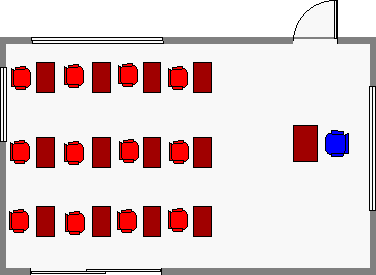
The basic principles of teaching relate to effective communication and should be visible within a lesson plan. By communication is meant the whole environment of effective teaching as well as simply verbal speaking and listening (each by student and teacher). Here is outlined the basics of teaching and communication, the barriers to communication and overcoming them, their application within teaching methods and how this might look in an imaginary lesson plan.
The first consideration is the room environment, which is part of the preparation. There are a number of room seating preparations possible, and I have experimented with several. In IT teaching I have been limited to the terminals type teaching, but have never used it elsewhere (except exam invigilating, illustrated below) because it inhibits conversation between students. It only suits the cognitive domain of teaching for individual feedback as in a test.

In the main I have taught with the "semi-circle" layout (illustrated below, although rarely is a semi-circle made). This seems to be the most common seating arrangement and effective regarding students as individuals. 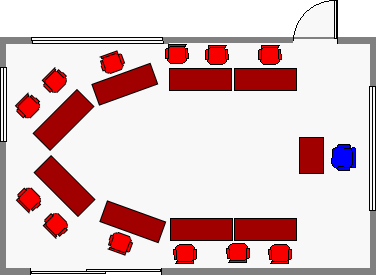 It aims to give the teacher the best view of all the students and the students' best view of the teacher and perhaps one another, and it encourages individual participation to the whole class (better than rows). However, I have made a point of abandoning the chair behind the desk and have sat within the semi circle in order to see which students sit where (who is eager, who is "hiding") and to suggest that we are all learning together.
It aims to give the teacher the best view of all the students and the students' best view of the teacher and perhaps one another, and it encourages individual participation to the whole class (better than rows). However, I have made a point of abandoning the chair behind the desk and have sat within the semi circle in order to see which students sit where (who is eager, who is "hiding") and to suggest that we are all learning together.
However, in Sociology, I have also taught to the "committee table" setting. Although I did not choose this, I liked it because it emphasised the group over individuals by bringing all people together, and seemed to create a greater necessity of effort. I rarely sat centrally down one side.
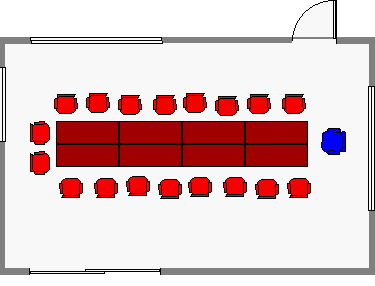
In some Research Methods teaching I used a resources room which was laid out in a "syndicates" fashion (illustrated below). In this I noted that students with similar projects gathered together, and also students with similar levels of motivation even where their projects were different.
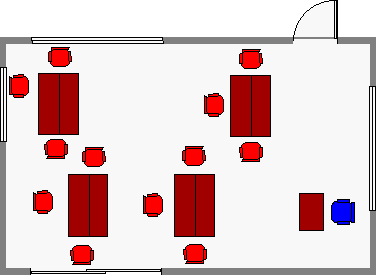
Layouts alter the area of maximum interaction from a teacher's sitting position. This might be a triangle with the teacher at the central corner, but in semi-circles this becomes distorted, because student participation grows with the nearness of student to teacher (Curzon, 1997, 196-197). Also students can face away from the teacher as in the syndicates layout (the diagram shows how this is prevented). All but rows (illustrated)
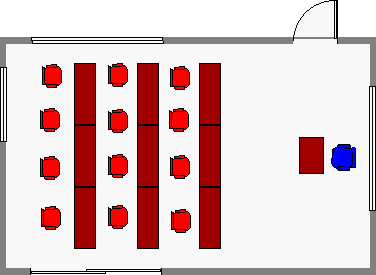 facilitate teacher movement, with the syndicate being a more informal movement than the directness of the semi-circle, equivalent of the interrogative style of the BBC 2 "Hypotheticals" programme. Also effective learning and teaching must take into account the fact that students prefer informality, and students prefer not to move around (Curzon, 1997, 196): although this clashes with putting introverted students within the area of maximum interaction and extrovert students outside it, and the desire to move students around if there is a need to emphasise the place of the whole class(see Smith, 1988, 43, on changing positions to create dynamic tension).
facilitate teacher movement, with the syndicate being a more informal movement than the directness of the semi-circle, equivalent of the interrogative style of the BBC 2 "Hypotheticals" programme. Also effective learning and teaching must take into account the fact that students prefer informality, and students prefer not to move around (Curzon, 1997, 196): although this clashes with putting introverted students within the area of maximum interaction and extrovert students outside it, and the desire to move students around if there is a need to emphasise the place of the whole class(see Smith, 1988, 43, on changing positions to create dynamic tension).
So the room aims to aid communication, in setting up the loop between the teacher getting the message across, the students developing that message amongst themselves in conjunction with the teacher, and in feeding back the reception of the knowledge to the teacher. However, the room is not enough. There are other areas of communication to consider and barriers which easily develop.
One problem area is verbal. A teacher who mumbles to the board, who swallows words, who speaks in a monotone manner, who says unexplained technical and specialist terms, who does not repeat points and speaks too quickly, is less effective, no matter how well the tables and chairs are arranged. My training in preaching liberal religion involved exercises in capturing and not losing the ends of sentences, in keeping words simple, in extending gaps between points but speaking at a reasonable pace (it can be too slow), and in repetition. This overlaps with the teacher's need to be clear.
There are non-verbal barriers to communication too. A teacher needs to have the right physical appearance. For myself, as a cognitive co-learner, I prefer a more informal dress style but if I was too scruffy then it might look as if I did not care or was not professional. Poor eye contact shows a lack of interest, but, the other way, touching is excessive and a student would not do this to me! I notice when a student is copying my gestures so it can be irritating if I did this, however it can indicate that a student is "in tune" or is comfortable with what is being said. On the other hand, if mirroring is deliberate then this is rebellious behaviour! Walking too quickly up to someone, waving arms about like the late Magnus Pyke, pointing, and having an over obvious speech or motion defect can all inhibit learning; but against this a student as much as a teacher should in the end learn equal opportunities regarding aspects of personality, culture or a medical condition. Tolerance is part of learning too.
Tolerance in the teacher is the awareness that some students have their own learning difficulties. One that affects everyone and relevant to adult education is the time of teaching - late classes are perhaps the least effective. Even afternoons and Friday afternoons present problems of concentration for some, but evenings often follow a hard day's work. Then some students will have eyesight difficulties, or hearing difficulties, or other personal medical needs, and many students are unwilling to discuss these certainly in public, or the matter seems to never arise. Some students have English as their second language. So there should be a confidential method in which the teacher finds out about and adjusts for such difficulties. It may mean being closer with self and board to them, larger than usual font sizes on handouts, projecting the voice more and speaking more slowly and staccato-fashion, and avoiding red and green contrasts in uses of colour. A number of people also find absolute silence a problem because of tinnitus.
By overcoming these inhibitions to communication, the teaching and learning loop is more likely to function effectively. Positively speaking, these improve communication:
(directly from Child, 1997, 236-237)
All aids to communication can be brought into a lesson plan and its variety of teaching methods, from the planned seating arrangments (if practical) to a variety of methods that retains interest. But much will rely on the awareness of the teacher during the performance of teaching.
The lesson may begin, if it is not the first one of term (where class bonding sessions may be a good idea), with a recap of previous learning. This also establishes the entry level of the lesson, which should be progressive from the previous lesson. The lesson itself should contain a variety of methods, and opportunities for reinforcement and feedback, and come to a strong conclusion that as best as possible ties up the themes of the day (this might doouble with the preparation for homework). The lesson should also, like any timetable, contain "slack" so that there are points of catching up.
The lecture is relied upon in many subject areas as a way of imparting the basics of the syllabus across to the mass of students on a course. In my Research Methods teaching I was able here to speak to all students at once. Yet I was aware of the limitations of this method, from the parallel I drew with preaching liberal religion. Preaching is a dreadful way of getting information across, and so is overlong lecturing. A sermon should last ten minutes and never more than twenty minutes, emphasising only one or two themes! A timetabled lecture goes on for fifty minutes and it is hoped students write notes to aid memory. I noticed how often I would speak to some students directly after a lecture, and seminars were there to support the lecture, as had been the case in Sociology where I was the support to someone else's lecture (which I often attended myself)
A preacher is aware, and even should expect, that listeners will drift off into their own thoughts, because there is a meditative function throughout a religious service; whereas the teacher wishes to be heard and remembered. A teacher who relies on lecturing, and fails to vary the learning activities, will be as ineffective as the sermon. Reece and Walker give the lecture a very low score in the cognitive domain alone (2000, 136). One wonders why one would bother at all. My answer is because lectures regulate information and tie information to the syllabus. I have found them to be a key signpost when I was a student and were the basis of exam revision.
Of course students often like to let the teacher go on and on, because as they write notes it simplifies the students' task especially with handouts. But a handout itself usually reduces the level of notetaking, and attention reduces further, and often there is no memorable link made between the handout with its summary and the lecture that expanded some points. My lectures were put on the internet, and I found students at my website, and then they weren't always at the lecture, but it let me do a lot more ad-libbing and talking around the subject.
Lectures are best bite-size with other methods as reinforcements, and as clarifiers to what was discovered by another method. However, there is a problem here. A repeated technique of a lecture segment that states what was discovered clumsily by students may cause students to think that their discovery phase is largely a waste of time, or could never be "as correct" as when the teacher speaks and gets it right. So somehow that mini-lecture has to add value to the classroom activity, not work as its correction. If it does, and the pattern is set, then the lesson will be seen as somewhat inefficient and time wasting.
The lecture improved with overhead projector transparencies and bullet points in handouts can turn into being all about bullet points, and it suggests a philiosophy of knowledge that everything can be reduced down to bare essentials.
A way to wake people up is a question and answer session, or several. Questions given out to the whole class can lead to embarassing silences, so often the question is directed at individuals. It then takes a brave individual to say they do not not know anything, and may try at least some sort of answer. Announcing that there will be question and answer sessions in advance is one way of ensuring that attention levels will be higher beforehand. Gathered knowledge that a teacher from time to time asks the distracted and distracting person a question also tends to increase the level of involvement, although I have thought, in adult education, that if someone is not taking part but not being disruptive then such is their choice and lookout, followed by a personal enquiry later on as to why they seem to be so uninterested.
The questions are best when requiring developed answers, and often lead to further questions, or revealing areas where further understanding is involved. In the Research Methods I would tease out from accounts of specific work generally applicable points which became questions (or lead to very mini-lectures and a flurry of note taking for a minute).
Behind this was their own project work. There was a requirement to hand in work by a certain date which would be, afterwards, their work for the term. Where I knew that students were sharing topics, I encouraged working and discussing in groups. This sometimes meant students across different classes. Therefore the seminars towards the latter part of the terms ceased to function and were replaced by resources room working and also by individual and small group meetings, sometimes in the back of the staffroom and sometimes in a spare room if not in the original classroom. I did some email responses too, reading attachments at home.
Project work is in-depth, and theirs needed study skills training in the seminars (as they came to an end), and in fact I changed the last lectures to be effectively about reading and writing. The work handed in before the final work was not given a clear marking system and was given a commentary not a mark. This goes against normal practice but was deliberate. I simply argued in detail with individuals the quality and clarity and direction of the work. Some students found this method to be difficult. They thought they were doing well, and I always praised what they were doing well (like effort and reseaching) but I would discuss the clarity of what they were saying. I pointed out that I suffer from the same problem myself! So they had to assume the relative ignorance of the reader on their topic, and I would say I was not actually teaching their topic. So perhaps they could watch their technical terms. Some effort went into teaching referencing, and I demanded that where they used something they should always reference it, and put even the date of the Internet find because it changes day by day as well as to be aware of its untrustworthy nature.
Amongst Research Methods students the level of discussion was limited by the individual nature of the project work. But for Sociology students discussion was the main hoped for teaching method of the seminars (where they did an absolute minimum of preparation). I often found myself dropping into mini-lectures, which to otherwise pyschology students was no bad thing. The discussion followed the lecture, and my objective was whether they understood the lecture, and whether they were on to the key points they needed for exam revision. So I tried to shut up to see if the quality of understanding was there, especially when they spoke amongst themselves, directing points (almost question and answer at times) to individuals who were not speaking.
The following lesson plan attempts to incorporate some different teaching styles. It is necessarily artificial in that it never happened, and does not have a separate lecture. The plan relates to study skills (based on Marshall, Rowland, 1998, 231-244), with development through to the ability to reference material and produce a bibliography. Its closure (Child, 1997, 129) is giving homework. It leaves footnotes and endnotes until a following lesson, which could follow a recap.
Lesson Plan |
|||||
| Name of candidate | Adrian Worsfold | ||||
| Date | Imaginary | ||||
| Time | Two hours | ||||
| Place and room | Imaginary | ||||
| Group | BA Research Methods | ||||
| Subject | Study skills - using conventions | ||||
| Resources | Overhead projector, Overhead projector transparencies, various books, prepared handouts | ||||
| Aim of Lesson | Understanding of referencing conventions | ||||
| Objectives | The student will be able to:
|
||||
| Evaluation of Lesson: (to be further developed in Learning Development Journal) |
|||||
| Still to do: Footnotes and endnotes |
|||||
| Time | Lesson content | Delivery methods |
Assessment method | Resources | |
| Teacher activity | Student activity | ||||
| 10 minutes | Importance of referencing, avoiding plagarism, common pitfalls in students' work in general | Speaking | Listening | Homework | Examples of quotes in OHPs |
| 15 mins - writing and presenting | Why are quotations useful? | Introducing and walking around | Buzz groups - ideas on to group sheets and then presentations | Seeing the presentations | Large sheets, marker pens |
| 10 minutes | Quotations - succinct, illustration, flvour of a work, to analyse author's exact words | Mini-lecture | Listening, writing, reading | Hand in work later | Handouts |
| 25 minutes | A succinct quotation from a larger text, also referencing it from details | Handing out large text, explaining task | Reading, writing | Handing in result, homework | Prepared handout |
| 10 minutes | Succinct quotes | Questions - "Where did you start the quote and why? Where did you finish the quote and why?" | Answers by individuals | Replies given | From own work |
| 10 mins | Method of bibliographic referencing (keep to one to avoid confusions) of books of one, two and more than two authors | Lecture | Watching | Homework | OHP |
| 20 mins | Writing out bibliography | Individual attention | Writing references | Homework | Details of books and quotes in handouts |
| 5 mins | Bibliographic entry is source without specific page number at essay's end, reference can go to it from within the text | Brief explanation | Listen | Homework | Use of existing work by someone in the class |
| 15 minutes | About the homework | A brief explanation followed by class discussion on what is required | Asking questions, making sure, writing nores, reading handout | Homework | Handout with requirement to produce a succinct quote from a book, reference it, build a bibliography of three books of one, two and more than two authors each (may require library use), and finally the choice of quotation and reasons for its length. |
Barnes, D. (1976), From Communication to Curriculum, Penguin.
Child, D (1997), Psychology and the Teacher, sixth edition, Cassell.
Curzon, L. B. (1997), Teaching in Further Education: an outline of principles and practice, fifth edition, Cassell.
Marshall, L., Rowland, F. (1998), A Guide to Learning Independently, 3rd edition, Buckingham: Open University Press.
Reece, I., Walker, S. (2000), Teaching, Training and Learning: a practical guide, Sunderland: Business Education Publishers.
Rogers, A. (1996), Teaching Adults, second edition, Buckingham: Open University Press.
Smith, A. D. (1988), Starting to Teach: surviving and succeeding in the classroom, Kogan Page.
Adrian Worsfold
http://www.pluralist.co.uk
adrian@pluralist.co.uk